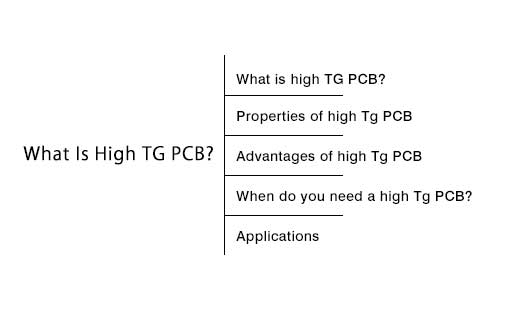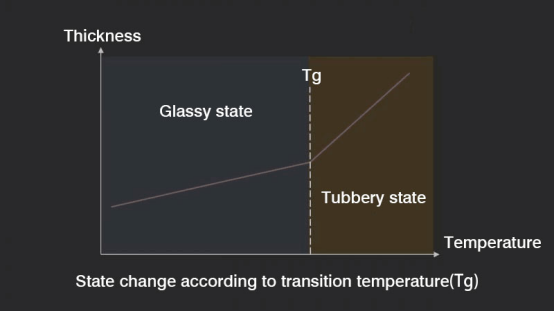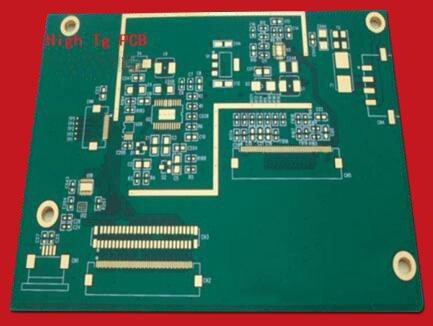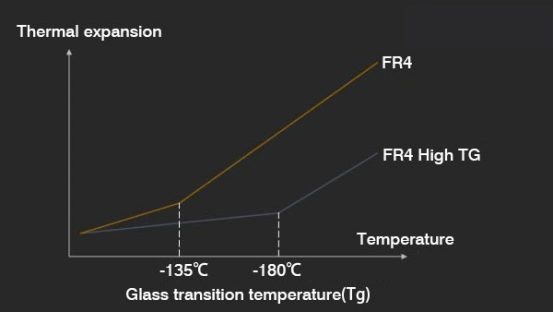What Is High TG PCB?

With the development of electronic technology, there is a great demand on the boards with high Tg. And Tg is one of the most important properties of any epoxy and is the temperature region where the base material (polymer or glass) changes from a solid, rigid and glassy state to rubbery state. Every PCB has a different Tg value based on its substrate. And PCB will start to change its state which will make a bad effect in PCB fabrication if the operating temperature of PCB exceeds its Tg value. High Tg PCB boards have a better stability at high temperatures because the substrate provides better heat resistance, mechanical and chemical stability for the board.
So the Tg value should be at least 20-25 degrees centigrade higher than the expected operating temperature of the device for which the board is used as choosing a PCB. For example, if you have a board with a Tg value of 130 degree centigrade than the working temperature of the device should be lower than 110 degree centigrade.
What is high TG PCB?
As you know, the base material (polymer or glass) is shifting from a glassy, solid, rigid state to rubbery state when the temperature goes up to a certain area, so the temperature just at this moment is called the glass transition temperature (Tg). that is to say, Tg is a mechanical property that designates glass transition temperature, that is, the highest temperature at which the substrate remains rigid. In other words, the normal PCB substrate is no only softening, deformation, melting, as well as other phenomena at high temperatures, but also there is a sharp decline in mechanical and electrical properties, which will make an effect on product life.

Needless to say, a normal PCB FR4-Tg is 130-140 degrees, the medium Tg is greater than 150-160 degrees, and high Tg is greater than 170 degrees. High FR4-Tg will have better mechanical and chemical resistance to heat and moisture than standard FR4. The higher the Tg value, the better the temperature resistance of the material, so high Tg is more and more popular particularly in lead-free process.
Properties of high Tg PCB
With the rapid development of electronics industry, high Tg material is widely used in computer, communication equipment, precise apparatus as well as instrument and so on. Toward to the high functionality, high multi-layer development, PCB substrate material needs higher heat resistance as a prerequisite. And the boards are more and more inseparable from the high heat resistance of substrates in the case of thinning, small aperture, fine wiring because of he emergence and development of high-density mounting technology represented by SMT and CMT. So the difference between general FR-4 and high FR4-Tg is that the mechanical strength, adhesion, water absorption, dimensional stability, thermal decomposition in the hot state, especially after water absorption, which are differences in various conditions such as thermal expansion, and it is obvious that high Tg PCB is better than ordinary PCB substrate materials. So there is a great demand on high Tg PCB in recent years, but the price are more higher than ordinary PCB.
What’s more, High Tg material is also popular in LED lighting industry, because hat dissipation of LED is higher than normal electronic components, but same structure of FR-4 board is much cheaper than metal core PCB, such as aluminum PCB.
High Tg materials have the following properties:
Resistance to high temperatures
Long delamination durability (aging of materials to consider for safety reasons)
Low thermal expansion
Excellent PTH reliability
Good mechanical properties
High temperature durability
High value of thermal stress resistance

Advantages of high Tg PCB
Higher stability: it will automatically improve the heat resistance, chemical resistance, moisture resistance, as well as stability of the device if increasing the Tg of a PCB substrate.
Bear high power density designs: high Tg PCB will be a good solution for heat management if the device has high power density with quite high heat generation rate.
It can achieve with using a larger printed circuit board to change the design and power requirements of a device when reducing the heat generation of ordinary board, what’s more, it also can use the high Tg PCB.
Ideal for multilayer & HDI PCBs: there will lead to high levels of heat dissipation because multilayer & HDI PCBs are more compact and have dense circuits. So high Tg PCBs are often used for the multilayer & HDI PCBs so that it can make sure reliability in PCB fabrication.
When do you need a high Tg PCB?
If you printed circuit board can not bear a thermal load no greater than 25 degrees centigrade below the Tg, you will need a high Tg PCB for your applications. What’s more, it also make sure safety with high Tg PCB if your product is operating in the 130 degrees centigrade range or higher. Needless to say, the main reason for high Tg PCB is the movement to RoHS PCB. So there are more and more PCB industries moving toward high Tg materials as the lead-free solder to flow needs higher temperatures.

Applications
If there is a higher power density in electronic products and heat generation will tend to disturbing heat sink or other parts of the products, so high Tg PCB is the best solution. What is more, you can find that Tg PCBs are applied in electronic industries which can operate in relatively high temperatures as high Tg PCB are more and more popular in recent years. So we serve customers from different industries by providing high Tg PCBs with heat resistance that meet the demands of customer’s specifications in quick lead time. So they are some application example as follows:
Gateway
Rfid
Inverter
Antenna
Wifi Booster
Contract Manufacturing Services
Low Cost Plc
Embedded Systems Development
Embedded Computer Systems
Ac Power Supplies
The specifications we can make, please check below:
Layer: 1-14 layers
PCB size: Min. 10*15mm, Max.500*600mm
Finished board thickness: 0.2-3.5mm
Copper weight: 1/3oz-4oz
Surface Finish: HASL with lead /HASL lead free/Immersion gold/ Immersion silver/Immersion Tin/OSP-Organic Solderability Preservatives - RoHS
Solder mask: Green/Red/Yellow/Blue/White/Black/Purple/Matt Black/Matt Green
Silkscreen: White/Black
Min copper tracks/spacing: 3/3mil
Min holes: 0.1mm
Quality Grade: Standard IPC II


